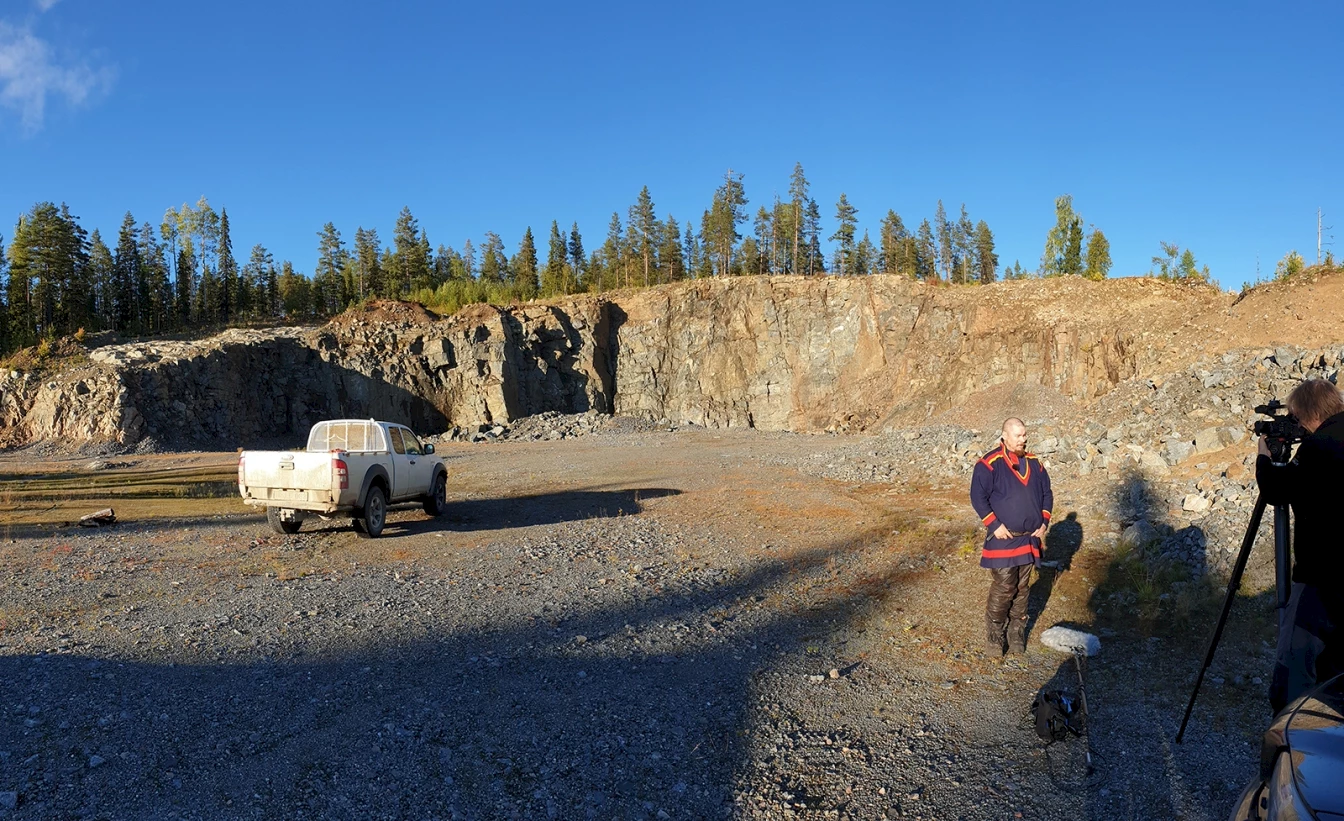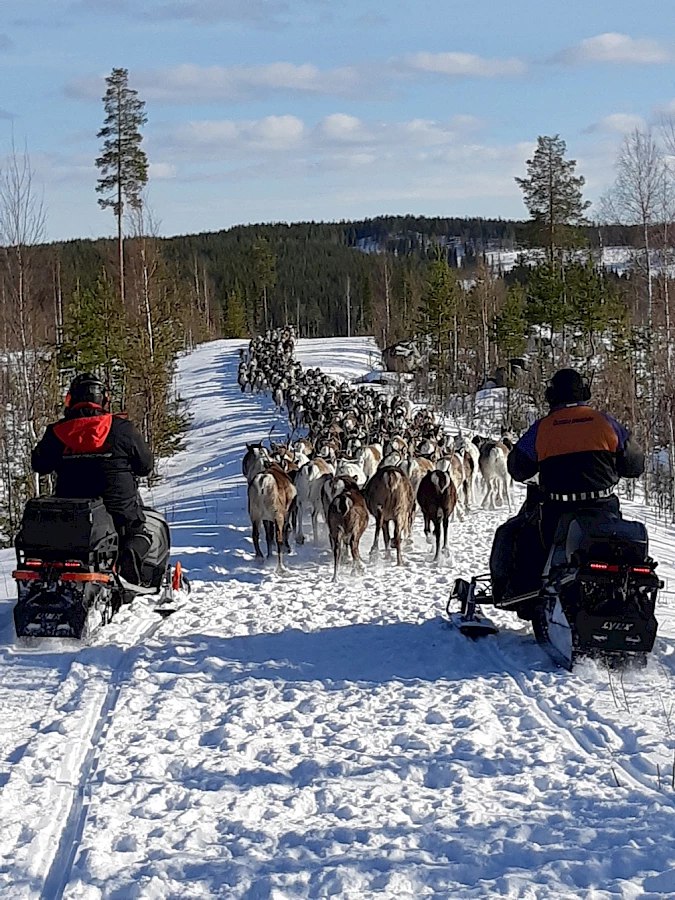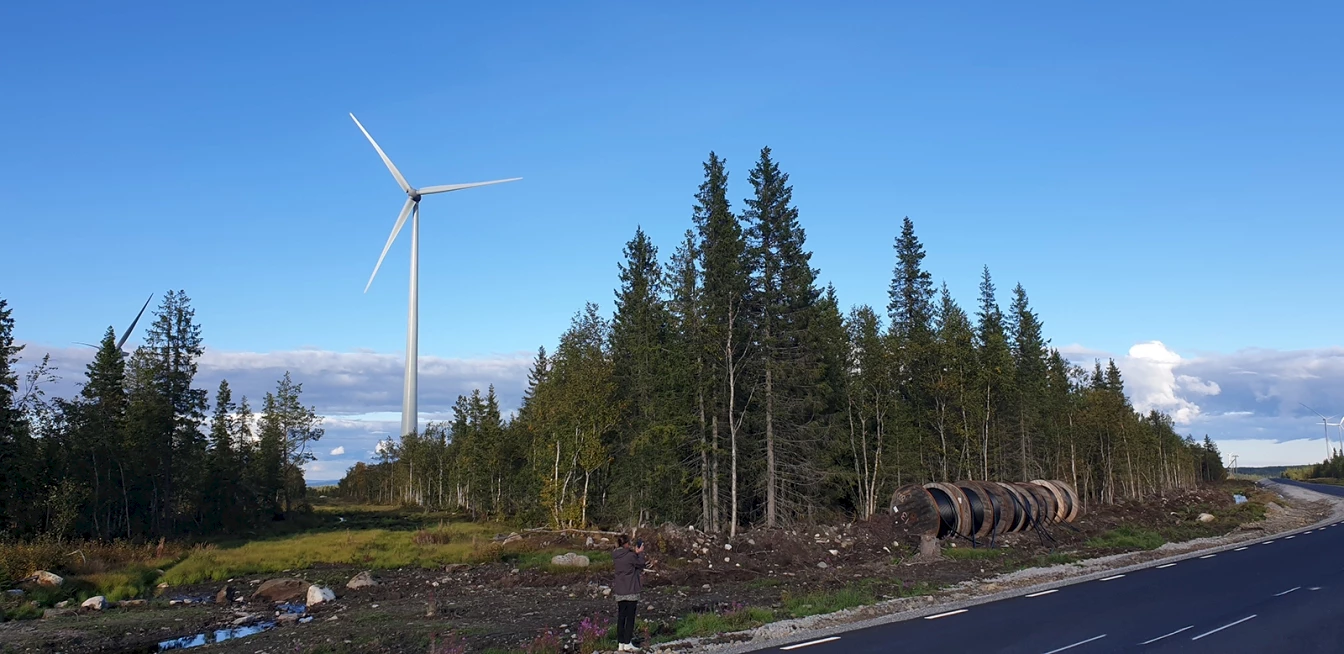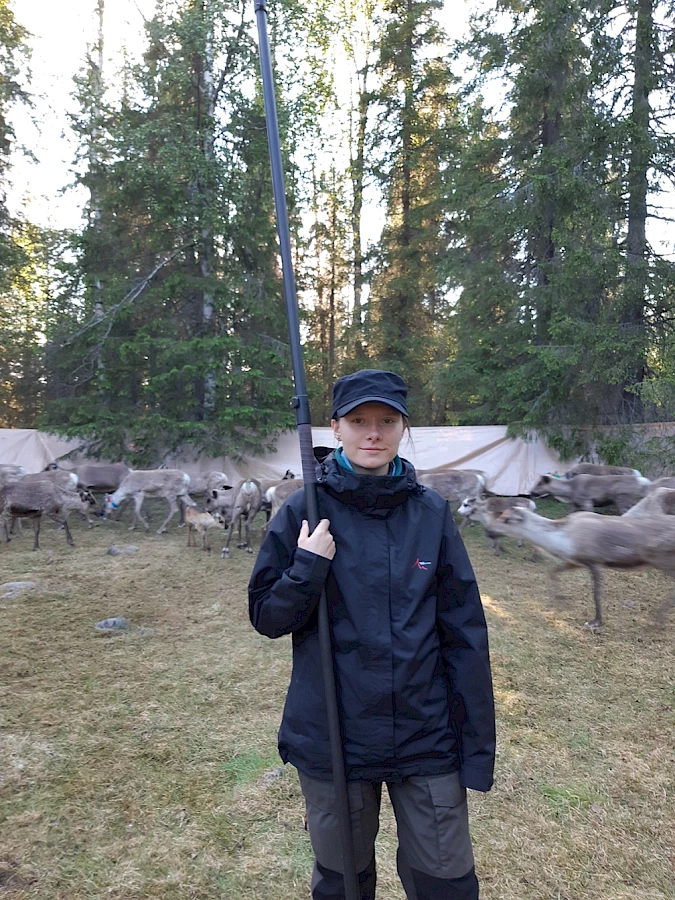Settler Colonialism in Ungreen, Climate-Unfriendly Disguise and As a Tool for Genocide
More recently, the concept of settler colonialism has come to be used increasingly in analyses of the colonial relationships between the Swedish state, the Swedes, and the Sámi. The history of interaction is complex, as the territory has been shared for millennia. The concept of settler colonialism is nevertheless useful to apply to strategies that aim to displace Indigenous rights to the lands and waters and replace them with those of the settlers, as if the settlers hold equal and/or authentic rights as heirs. Furthermore, a specific way of life—that of the settler—takes precedence, whereas nomadic lifestyles are considered to be outside of the normal way. The colonial state’s ethnic cleansing of Sámi forms part of these settler-colonial practices, within which racism has been, and still is, used as a tool.
In this essay, I discuss some of the perspectives on “climate change” and “green transition” I have come across within my research and supradisciplinary collaboration over the last two decades. I also argue for the use of the concept of (cultural) genocide as a basis for discussing the Swedish state’s actions and policies regarding the Indigenous Sámi.

Reindeer herder Hendrik Andersson explains to the camera the consequences of wind-power plants built on the Sámi village reindeer grazing lands of Gällivare Forest. He is standing in a quarry dug to build forestry access roads. Wind power will require more roads and quarries—intensifying the encroachment on grazing land. Operating the camera is Petri Storlöpare, filming for the Dálkke research group’s documentary Ungreen Windpower: Sámi Indigenous and Scientific Perspectives on Fossil Dependent and Environmentally Destructive Designs (2021); youtube.com/watch?v=vMq-Yah4RL0. Photo by the author.
Wind Power as a Tool of the Settler-Colonial Destruction of Sámi Livelihoods and of Sámi
Over the course of more than ten years we have fought against wind power on our calving lands, around Hällberget. We lost the case and now the future seems dark. I have promised Vasa Vind that nothing will be built as long as I live. If they start building, they will have to run me down. I will use every day to stand in the way with my body, to stop this destruction. We have used the legal path as long as it is possible, it seems. As we cannot protect the calving grounds, it must be the legislation that is wrong. It is 2022, and we are about to lose the nursery for our reindeer. #greencolonialism #wewillneedhelpheresoon #flakaberggroup #theSámivillagehasopposedfromday1 #onefeelslikeshitwhenonecannotdomore1
The above quote is from a social media post made in March 2022 by Henrik Andersson, reindeer herder of the Gällivare Forest Sámi village in Norrbotten, the northernmost county on the Swedish side of Sápmi, the Sámi territories. In February 2022, after a decade of legally opposing the establishment of a wind-power industrial area within their calving grounds, the Gällivare Forest Sámi lost in court when their appeal against an earlier ruling was turned down by the settler-colonial (Swedish) Land and Environmental Court of Appeal. For Henrik Andersson and the Gällivare Forest Sámi village, this was but one of many struggles they continue to pursue to protect the reindeer from complete extermination by the Swedish state; to protect traditional Sámi livelihoods, to protect the lands, the waters, and the climate.
The Gällivare Forest Sámi currently have several court processes underway. Apart from the Vasa Vind wind-power industrial establishment (owned by Dutch pension fund APG),2 the Swedish state power company Vattenfall also plans to produce wind power on a large area within the territory of this Forest Sámi village.
As well as protecting their lands against ungreen and destructive wind power, the time and energy of Sámi villagers and reindeer herders is also taken up by having to deal with several other issues that undermine the possibility of long-term sustainability for us all. The fact there are too many predators that kill the newborn calves causes constant work for the Sámi each spring, when they must report to the county administrative board to apply for permits to hunt down certain individual predators that cause major havoc, each one killing several reindeer. There are railways that kill thousands of reindeer every year, yet little to no work is done to change this for the better.
Twice per year, the Gällivare Forest Sámi village herders need to cross the E4, the highway that runs through the whole of Sweden, with their reindeer. When Henrik Andersson started as a herder about twenty-five years ago, this was rather easy. But today the fences and the increased traffic have turned the highway into a death trap, for both the reindeer and their herders.
Most Sámi villages, including the Gällivare Forest Sámi village, have one or several mines with tailing dams within their territories.3 Furthermore, there are local inhabitants who pursue settler colonial logics by attacking their reindeer; shooting or hitting them with cars, trucks, or snowmobiles. In schools, in society, and online, there is outright hate and racism directed toward those who openly display Sámi identity, and this is encouraged by those Swedish state representatives, of both local and regional authorities, that ignore and render Sámi culture and history invisible.

Gällivare Forest Sámi village, April 2022. One of the good days; life as it should always be. Flakaberg group herders Hendrik Andersson and Michael Guttorm Eriksson gently follow their reindeer as they move back to their summer grazing lands and calving grounds. Photo by Tina Eriksson. Image courtesy of the author.
The Sámi Work to Protect the Environment, Their Culture, and Long-Term Sustainability
The Sámi’s labor to protect their livelihoods, along with animals, the environment and nature—that is, their work toward long-term environmental and social sustainability—has been ongoing for more than a century. Reindeer herding has become increasingly difficult over the last century due to multiple factors including settler-colonial theft of lands and waters, legislation, and increasing industrial exploitation. Never silent, ever since the early Sámi human rights defenders Elsa Laula and Karin Stenberg published their books in 1904 and 1920 respectively, the Sámi have continuously challenged the aggressions of the settler colonial state.4 Supported by the Sámi community, they promoted the rights of the Sámi to their own lifestyle, education, and the opportunity to influence policy-making.
In the last decade, Sámi have had to start mobilizing to challenge what is commonly referred to as a “green transition” in the name of what is claimed to be a fight to stop climate change. In Sweden, the exploitation of rivers in Sámi territories to produce hydropower started in the early twentieth century, as the Swedish state aimed to become less dependent on imported coal for energy consumption. Most rivers in Sámi territories were affected, causing severe negative impacts on the local communities, to whom, however, little or no compensation was offered.5 Since the 1990s, when calls for renewable energy began to emerge, the Swedish state power board has promoted hydropower as renewable and environmentally friendly, despite the extensive negative environmental and social impacts that result from hydropower exploitation.6
Over the last decade, the push for “greening” has become a major threat to the livelihoods of Indigenous Sámi. The Swedish state has been taking over Sámi territories by unlawful means for more than a century. Starting on a large scale in the nineteenth century and increasing over the twentieth century, the last decade has brought the most forceful encroachments yet. Similar experiences are reported on both the Norwegian and Finnish sides of the Sámi territories, where climate change and greening discourse are being used as a tool—an excuse—for outright cultural genocide.
Reframing Swedish State Policies of “Fighting Climate Change” as Cultural Genocide
Sweden has been questioned and criticized several times by the United Nations Committee on the Elimination of Racial Discrimination over the treatment of the Sámi.7 However, the application of the concept of genocide is commonly avoided and rejected in this regard. This is in part due to the fact that Sweden and the other Fennoscandian countries are widely considered to be democratic defenders of human rights, and also that knowledge about the situation experienced by the Sámi has not yet been presented to the International Court of Justice. (This would be a difficult and costly procedure to undertake, both in terms of funds and in terms of the personal energy and capacity required to do so. It is not something a few individuals are likely to attempt on their own, without knowing that they have massive support.) Certain authors, activists, and politicians have indeed applied the concept of genocide, but with the addition of the term “cultural”—thus, “cultural genocide”—a slight modification, but one that might appear to soften it.8 While “genocide” is commonly understood as outright killing, “cultural genocide” is commonly understood as “the systematic destruction of traditions, values, language, and other elements that make one group of people distinct from another.”9 Genocide as such was first recognized as a crime under international law in 1946 by the United Nations General Assembly. It was codified as an independent crime in the 1948 Convention on the Prevention and Punishment of the Crime of Genocide, often shortened to “the Genocide Convention.”10 The definition of genocide as stated in the Genocide Convention, Article II:
In the present Convention, genocide means any of the following acts committed with intent to destroy, in whole or in part, a national, ethnical, racial or religious group, as such: Killing members of the group; Causing serious bodily or mental harm to members of the group; Deliberately inflicting on the group conditions of life calculated to bring about its physical destruction in whole or in part; Imposing measures intended to prevent births within the group; Forcibly transferring children of the group to another group.11
To meet this definition of genocide requires that one or several of these acts have been, or is being, committed. It is therefore reasonable to discuss certain actions taken towards the Sámi during the last century as actual genocide. While the outright killing of Sámi by the Swedish state is not known to have occurred during the last couple of centuries, occurrences of others of these acts are documented. The causing of serious mental harm to members of the group is well-known of, along with “deliberately inflicting on the group conditions of life calculated to bring about its physical destruction in whole or in part.”12 Sámi have worked hard to make known and challenge such acts since the 1904 publication of South Sámi woman Elsa Laula’s book Inför lif eller död? Sanningsord i de lappska förhållandena (Life or Death? True Words Concerning the Situation for the Sámi). In this book, Laula describes the harsh conditions of life for the Sámi, bereft of their lands by the Swedish state and thereby of their means to survive. In 1920, forest Sámi woman Karin Stenberg published another strong critique of the Swedish state’s treatment of the Sámi, calling for the strengthening of the Sámi people’s rights to survival and well-being.13 Evidence for the forced transferal of Sámi children to another group may need further investigation, but the forced placement of Sámi in residential schools where they were not educated to the same extent as Swedish children, while also being forced to unlearn Sámi traditions, culture, and language, has been documented and challenged by Sámi.14
Throughout the twentieth century the Sámi mobilized and repeatedly demanded their rights to life and well-being, and they continue to do so to this day. It would have been impossible for Swedish state representatives to avoid hearing at least some of these calls and demands. That they did hear some, at least, is reflected in the fact that, in 1977, the Swedish parliament came to refer to the Sámi as Indigenous; in 2000, the Sámi were granted rights as a national minority, and in 2011 their status as a people was granted within the Swedish constitution.15
Over the last century, Swedish state policy-making generally has neglected the spatiality of Sámi livelihoods, in regard to reindeer herding and other everyday practices.16 One of the consequences of the government policies that have resulted from this neglect is that reindeer herding is near collapse in certain areas, and thereby an important part of Sámi traditional culture is also.17
The ultimate consequence of this aggressive neglect is a negative path toward the total eradication of Sámi livelihoods.18 Again, when compared with international experiences of similar actions, the resultant extermination can be interpreted as genocide. If successful, it will fulfill earlier attempts by the colonial nation states to push the Sámi away, eradicating the Sámi lifestyle and leading to further forced assimilation and destruction. Furthermore, the physical and mental health situation for many Sámi, reindeer herders in particular, is already severe, as documented and verified in several studies.19
Meanwhile, the absence of Sámi representation in Swedish government inquiries and commissions that are dealing with issues that concern Sámi livelihoods—the 2017 Energy Commission, the 2019 Inquiry on Water and Hydropower Related Activities, and the ongoing National Forestry Program,20 for example—seems to be a general trend, yet one that currently does not seem to be regarded as an important issue for consideration by state representatives or the Swedish parliamentarian majority. And while there is Sámi representation within the ongoing inquiry into the reform of legislation on reindeer herding,21 among the government-appointed experts there are only Swedish scholars. That no Sámi scholars were invited indicates that Sámi scholarly expertise is being ignored while the Sámi are restricted to occupying those positions within the inquiry wherein they can more easily be controlled.

A 200-meter-high wind turbine in Markbygden, Norrbotten county, one of 314 covering 140 square kilometers of the herding grounds of the Forest Sámi village Östra Kikkejaur with access roads and cables. 75 percent of this wind-power plant is owned by the Chinese state-owned company CGN. Photo by the author.
Wind Power and Ungreen Transition—Pursued to Terminate the Sámi Way of Life
As a member of the ongoing research group and project Dálkke: Indigenous Climate Change Studies at Uppsala University, I have been involved in investigating the consequences of wind power exploitation for the Sámi reindeer herding community of Gällivare Forest Sámi village.22 It is of importance, first of all, to challenge the “green” in the so-called “green transition” of today. Looking closely at wind power, we have noticed that the planning processes do not reckon with all the relevant aspects of wind power’s own fossil-fuel dependency and other environmental consequences. Firstly, a large part of what is needed to establish, maintain, and eventually decommission wind power plants and industrial areas is never taken into account within their so-called “life-cycle analyses” (LCAs). These estimations are made by the parties that wish to construct wind power, and they are not verified by any objective party. Secondly, most of what is needed to produce wind power is excluded from LCAs. This is what makes it possible to (falsely) claim that wind power within the current design paradigm is green.23 Thirdly, the establishment of wind power is a serious threat to the Sámi way of life. This case has been argued by Sámi villages on the Swedish and Norwegian sides for many years now, both in opinion pieces and court processes. Yet, the Swedish court system continues to give wind power companies the right to establish production on Sámi grazing and calving lands, while ignoring Sámi rights, as in the case of Vasa Vind and the Gällivare Forest Sámi village.
I end this essay with the words of a young Sámi woman of the Gällivare Forest Sámi village, Elle Eriksson, posted on social media after the decision by the Land and Environmental Court of Appeal to reject their complaint against Vasa Vind in February 2022:
My present, past, and future. These are threatened by the planned establishment of a wind power farm on Hällberget, which is situated within the traditional calving grounds of my reindeer herding group, Flakaberg.
My present is threatened because I, my family, and my relatives will be affected. For more than ten years, the reindeer herders of the Flakaberg group have tried to prevent the establishment of this wind power facility, since it will bring about devastating consequences. The female reindeers who have used this area for hundreds of years will not be able to give birth there anymore, the livelihood and the mental well-being of the reindeer herders are at stake, and the Sámi culture is infringed and disparaged. We will never experience a traditional calf-marking on our customary lands if this wind power establishment is realized.
My past is threatened as the traditional knowledge that my áddjá/grandfather and my áttje/father have will be lost if the nature that the knowledge is connected to is destroyed. The forests, lakes, mountains, and mires that my ancestors have used, and all the accumulated knowledge that they have passed on from generation to generation will be impoverished, and ultimately vanish. Will my áhttje be forced to carry the burden of belonging to the last reindeer-herding generation of the Flakaberg group?
My future is threatened due to the risk that I will not be able to continue with reindeer herding. The chain of reindeer herders that I am a part of will be broken. The legacy that I wish to preserve and pass on to future generations will be destroyed. The forest Sámi tradition that we are keepers of will be endangered. The history and posterity of an entire lineage will be ruined, all in the name of the “green transition.” Sámi rights, our rights, must be respected and our intrinsic value as an Indigenous people must be seen as self-evident. Sámi rights should not be considered as an interest to be “balanced” against other interests.
Lastly, I want to thank all the Sámi and non-Sámi who stand up for us and fight on our side. Your solidarity gives us more strength to continue our work to protect the present, past and future of the Flakaberg group.24

Gällivare Forest Sámi village reindeer owner Elle Eriksson, calf-marking in Vuoskon. Photo by Tina Eriksson. Image courtesy of the author.
The views and opinions published here mirror the principles of academic freedom and do not necessarily reflect the views or positions of the L'Internationale confederation and its members.